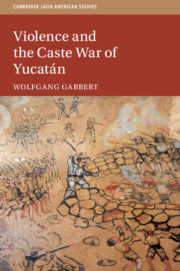Book contents
- Violence and the Caste War of Yucatán
- Cambridge Latin American Studies
- Violence and the Caste War of Yucatán
- Copyright page
- Dedication
- Contents
- Illustrations
- Acknowledgments
- Introduction: Caste War Violence – Prospect and State of the Art
- Part I Violence and War
- Part II Violence in Yucatán Before and Beyond the Caste War, 1821–1901
- Part III The Caste War and Violence: An Overview
- Part IV Violence and the Government Forces
- Part V Violence and the Kruso’b
- Part VI Intricacies of Caste War Violence
- Appendices
- Bibliography
- Index
- Other Books in the Series (continued from page ii)
Part II - Violence in Yucatán Before and Beyond the Caste War, 1821–1901
Published online by Cambridge University Press: 09 August 2019
- Violence and the Caste War of Yucatán
- Cambridge Latin American Studies
- Violence and the Caste War of Yucatán
- Copyright page
- Dedication
- Contents
- Illustrations
- Acknowledgments
- Introduction: Caste War Violence – Prospect and State of the Art
- Part I Violence and War
- Part II Violence in Yucatán Before and Beyond the Caste War, 1821–1901
- Part III The Caste War and Violence: An Overview
- Part IV Violence and the Government Forces
- Part V Violence and the Kruso’b
- Part VI Intricacies of Caste War Violence
- Appendices
- Bibliography
- Index
- Other Books in the Series (continued from page ii)
Summary
Violence was part of everyday life beyond the wars and rebellions for many Yucatecans, particularly in the countryside. This background provides clues to what was considered normal or expected behavior and should make it easier to understand why, for example, acting violently was not a remote form of settling affairs and why fleeing to the bush or joining the Caste War rebels were attractive options to many lower-class Yucatecans. Life was grim for the lower classes in nineteenth-century Yucatán. Their situation varied considerably depending on whether they lived in urban or rural environments, whether they were self-employed or not and whether they lacked or had access to some means of production. Physical force intensified the severity of these living conditions, in particular for the lower classes and dependents, i.e., wives, children, and domestics, all of whom were subject to patriarchal authority. As in most parts of the world at that time, violence was a day-to-day affair in nineteenth-century Yucatán. Lower-class males suffered physical aggression at the hands of superiors and were beaten regularly by hacienda overseers and parish priests.
- Type
- Chapter
- Information
- Violence and the Caste War of Yucatán , pp. 31 - 37Publisher: Cambridge University PressPrint publication year: 2019

